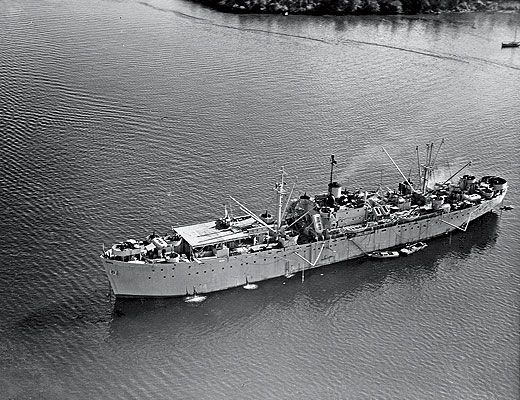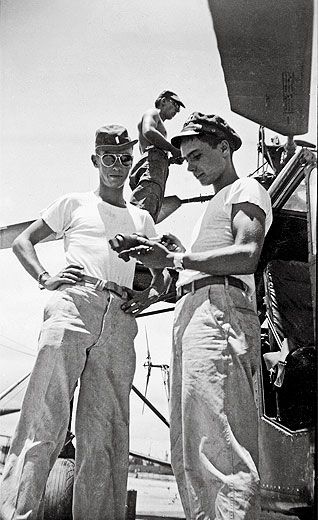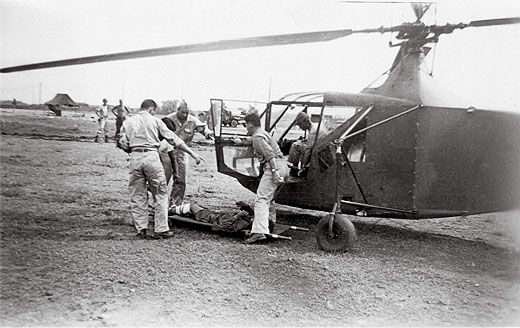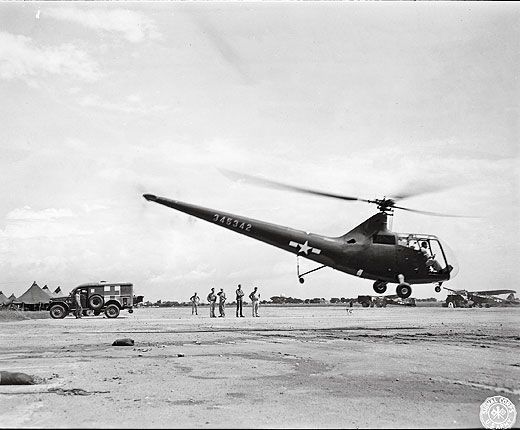Medevac From Luzon
A small band of helicopter pilots risked their lives to rescue wounded soldiers during World War II.
/https://tf-cmsv2-smithsonianmag-media.s3.amazonaws.com/filer/Medevac_FLASH.jpg)
Louis Carle thought his helicopter was small enough to land in a clearing on a jungle hilltop in Luzon. It was June 1945, the waning days of the Pacific war, and Carle, a second lieutenant in the U.S. Army Air Forces, was trying to evacuate a wounded American soldier from the main island in the Philippines. Carle began a cautious descent in his Sikorsky R-4B, but a rotor tip hit a tree, and with an abrupt jerk, the helicopter began thrashing itself to pieces.
After the helicopter hit the ground, Carle was helped from the wreckage. He found himself sitting in the midst of a small band of U.S. soldiers. Nearby, starving but well-armed Japanese squads were determined to resist to the end. With injuries to his head and leg and a splinter of a wood rotor blade lodged behind his right eye, Carle had no choice but to order the U.S. soldiers to fire bazooka rounds into the wreckage and destroy his helicopter. He then began an arduous trek out of the mountainous jungle. Before he reached safety, he encountered one of the Japanese soldiers. Carle, armed with a pistol, shot and killed him.
From June 15 to July 29, 1945, Carle and five other pilots evacuated 75 to 80 wounded soldiers, one or two at a time, from the highlands northeast of Manila. Although they were not the first helicopter pilots to fly in combat—that distinction belongs to Lieutenant Carter Harman of the First Air Commando Group, who flew the first medical evacuations, in Burma on April 23, 1944—they were the first to be targeted by enemy fire: Japanese soldiers tried to shoot them down with machine guns. Their six-week effort constitutes the largest combat helicopter operation before the Korean War, yet their contributions remain largely unknown.
The evacuation of casualties had been contemplated as a mission that helicopters could perform for the armed services, but it is not the mission that the six pilots were trained for, and it is not why their first-generation helicopters were sent to the Philippines. Pilots and helicopters had been assigned to the Pacific theater to ferry aircraft parts for a program known as Project Ivory Soap. With this project, the Army Air Forces used U.S. Army-owned ships as floating depots to maintain the aircraft of groups stationed in the Pacific. Early in the war, air groups often waited months for replacement parts and supplies to reach the Pacific isles on which they were based; with repair ships floating nearby, aircraft could be turned around much faster.
By December 1943, Project Ivory Soap had evolved into a fleet of six Liberty ships, designated Aircraft Repair Units (Floating), and 18 smaller ships, designated Aircraft Maintenance Units (Floating). In the final year of the war, the program proved essential for maintaining the tempo of Pacific-based aircraft operations by conducting nearly all of the most intensive maintenance functions, with the exception of engine overhaul.
By far the most distinctive feature of the floating repair ships was their helicopters. In addition to the R-4B, Sikorsky had made two other helicopters for World War II: the R-5 and R-6. The R-4 was a trainer intended merely to introduce the helicopter’s potential to the military; the R-6 was a further evolution, designed as a liaison aircraft. The R-5 was the true workhorse, the only one of the group capable of lifting a substantial load.
Unfortunately, the much larger R-5 suffered a series of engineering delays and was not ready for deployment until several months after the war ended. The R-6 also suffered delays, but saw limited service in the last three months of the war. That left the lowly R-4 trainer to bear the brunt of helicopter operations from April 1944 onward. Under ideal conditions, the R-4 could carry, in addition to the pilot and fuel, only 195 pounds, which meant only instruments and small components such as propeller hubs. But the timely delivery of even small payloads was highly valued.
The First Aircraft Repair Unit deployed on October 11, 1944, and by the following February, all six vessels were in the Pacific. At the start of June 1945, the Third, Fifth, and Sixth Aircraft Repair Units were operating in the Philippines, supporting the Fifth Air Force, while the remaining three supported the 20th Air Force in the Marianas. (The First and Second Aircraft Repair Units were specially equipped and trained to support B-29s in the Marianas, including repair of their radar and complex central fire control systems.) Each of the ships had a 40- by 72-foot steel deck for helicopter operations.
Carle and First Lieutenant Robert Cowgill were assigned to the Fifth Aircraft Repair Unit. On June 15, with Cowgill away to pick up the first Sikorsky R-6A to make it into the theater, the Fifth Air Force received a request from the 38th Infantry Division to evacuate two soldiers with head injuries from a spot 35 miles east of Manila.
Carle was immediately dispatched in one of the unit’s R-4s. Reaching what he thought was the designated spot, Carle recalled: “All hell broke loose as a hail of 100-pound bombs started dropping all around me. I got out of there but quick. When I got my breath back, I saw a squadron of P-47s dive-bombing the spot I had just been flying.” (Carle gave accounts of his rescue missions to Fred Duncan, the historian of the aircraft repair units, and me. We interviewed Carle and the other Ivory Soap pilots in 2000 and 2001 as part of an oral history project for the National Air and Space Museum. Carle died in 2000.)
As Carle landed at a forward position on Luzon, soldiers greeted him with incredulous looks and comments on his “monstrosity from the sky.”
They, like the vast majority of Americans at the time, had never seen a helicopter. The soldiers had no information on the wounded whom Carle had come to collect, but they did know of a platoon leader with a bullet-shattered hip; he was part of a patrol that had been cut off near a narrow river bank.
Arriving at the location, Carle realized just how unprepared he was for the mission. When deployed to the theater, he had a mere 25 hours of helicopter time, and no training in medical evacuation, combat flying, or landing in a jungle. While R-4s had had external stretcher mounts installed in trials, the R-4s assigned to the aircraft repair ships had no such equipment, and Carle had not given a thought as to how a two-seat trainer might evacuate somebody. “As I stepped from the ship, a grimy, bearded sergeant grabbed my hand and began pumping it, welcoming me as though I was his long-lost brother,” said Carle. “At the same time, he explained what had happened to his patrol leader, and asked for instructions for loading the stretcher. Somewhere he had read that a stretcher can be loaded onto a helicopter. His spirits seemed to drop to the earth when he heard that I had never seen a stretcher used on a helicopter and knew of no way to load a stretcher patient onto the R-4. One of his buddies spoke up, asking if a seat could be removed and the man placed on the floor. It could be done, and we did it.”
Carle also disconnected the cyclic stick, but the wounded lieutenant’s feet still had to be propped up on the rudder pedals with a seat cushion, an arrangement that, Carle noted, “served as a ‘rudder lock’ and gave me absolutely no control over the tail rotor.” After an ungainly takeoff, Carle slowly climbed away and was able to deliver his patient to the 311th General Field Hospital near Manila.
News of the successful evacuation spread quickly, and calls for Carle’s services started to pour in.
On June 17, Cowgill returned with the newly assembled R-6A; though this helicopter could perform slightly better than the R-4B, its cabin was even tighter. Carle evacuated the wounded who were unable to stand or sit, while Cowgill evacuated those who could walk. Both men quickly became exhausted. Carle remembered: “More and more units requested our services, until we were overloaded with work, as can be indicated by the fact that I flew seven hours and made six evacuations on the same day.”
By the standards of Korea and Vietnam, Carle’s workload seems trivial, but the R-4B was a far more demanding machine than its successors. The R-4B’s blades were constructed of wood ribs around a steel spar and covered with doped fabric. They were difficult to keep in track (rotating in the same plane) and vibrated excessively. The pilot’s cyclic stick made continuous small orbits, never staying completely stationary. There was no governor to control rotor speed, and the pilot had to correlate the throttle continuously with collective pitch inputs. In one of the only instances of public coverage given to the Ivory Soap helo pilots, a June 21, 1945 Chicago Tribune article reporting on Carle’s initial efforts noted: “Driving the ‘eggbeater’ is hard work. The control stick shakes like a jackhammer, and the pilot must hold it tightly at all times. Should he relax for even a minute the [helicopter] falls out of control. Pilots of regular planes say it’s easy to identify a helicopter pilot—he has a permanent case of the shakes.”
Besides wrestling with the helicopters, the pilots had to load and unload the wounded without assistants, which only added to the job’s stress. Not all of the pilots assigned to the aircraft repair units were suited to the medical evacuation missions. First Lieutenant Harold “Pappy” Greene walked away from helicopters after flying only two evacuations, swearing he would “never fly another helicopter—ever.”
Carle and Cowgill found their evacuations becoming more difficult. The pilots continued to discover unanticipated limitations on these first-generation production rotorcraft. Cowgill recalled that though the R-6 was intended as an improvement on the hastily designed (and perhaps overbuilt) R-4, it seemed to have numerous defects and was an even trickier machine to fly. “They had the fuel tank in front of the center of lift…so when you ran [low] on fuel, the nose began to rise and you would run out of forward stick if you [were] alone,” said Cowgill. “I had to stop once and put a stone up in the front to trim it up enough. It was just a completely stupid goof.”
Carle’s final disastrous evacuation demonstrated just how far beyond the design limits of the R-4B the pilots were going. With the heat, humidity, and altitude characteristic of central Luzon, the payload of the R-4 was essentially zero. To get off the ground, Carle had to employ a dangerous technique: the jump takeoff. In an article he wrote for the January 1947 issue of American Helicopter magazine, he recalled that he deliberately oversped his engine and rotor rpm past redline to “2,600 [engine] rpm and [pulled] 7.5 degrees pitch to start the takeoff,” causing the helicopter to leap into the air. The technique had numerous hazards, including the helicopter settling back onto the ground. Another danger was that either stress or the increasing air pressure at the blade tips would cause the blades to fail structurally. Over-revving did the engine no favors either, but Carle later instructed future helicopter pilots that “such a high rpm may shorten the life of the engine, but it will lengthen the life of the pilot.”
The high-torque maneuver also overwhelmed the R-4B’s tail rotor, and the “torque caused the tail to swing almost 90 degrees to the left.” The helicopter was then in an awkward position to depart the tight clearing, but Carle made the best of it. As his helicopter moved sideways, the rotor began to enter what is now known as “effective translational lift,” in which a forward influx of airflow increases rotor efficiency, providing just enough improvement in performance to keep the helicopter from settling onto the ground. Carle then noted that “as the ship picked up speed, the action of the wind swung the tail partially behind me…[but], as I started it soon became apparent that the 210 pounds of my passenger, plus the altitude of 1,500 feet were going to make it impossible to clear the high trees. The rpm was dropping rapidly, and the airspeed was near zero. I was at the limit of my climb and still the tops of the trees were above me. I couldn’t turn back without dropping straight in, probably killing the passenger and myself, so I jerked the pitch control as high as it would go and luckily we cleared the trees by inches, but the effort had cost [rotor rpm] and all of my airspeed.
“As soon as I realized that we were clear of the trees, I dropped the pitch to 4 degrees and held full throttle, at the same time pushing forward on the stick. As the rpm came back within the green, I increased the pitch and fortunately missed dropping into the jungle. Again, the rpm dropped, and again I lowered the pitch enough to bring it back. The airspeed was building slowly and we began to climb to safety. What had actually been a few seconds seemed an eternity. My clothes were drenched with sweat, and I was so weak that I could hardly move the controls.”
Carle’s experiences presaged those of countless combat helicopter pilots in the Korean and Vietnam wars, who were forced to master flying overloaded aircraft into tight landing zones; his recollections vividly illustrate just how risky these early operations were. On June 21, Carle and Cowgill both ran out of luck. Carle’s rotor tip hit a tree, and almost simultaneously, Cowgill, flying an equally treacherous approach in the R-6A, clipped a tree with the tail rotor. Fortunately, the troops at his landing zone were well positioned, and were able to post a guard to watch the aircraft (recovered a week later). Cowgill marched out of the jungle with an escort on a harrowing four-day journey in which he too encountered determined Japanese opposition.
The two crashes ended the Fifth Aircraft Repair Unit’s participation in the operation, as their ship was preparing to support the newly captured airfields on Okinawa. After Carle deployed with his vessel to Okinawa, the war ended. He went back to Luzon to fly R-6As with the Second Emergency Rescue Squadron, which was adding helicopters to an extensive stable of fixed-wing rescue aircraft. After returning to the United States, he suffered persistent pain from the rotor fragment in his skull and never flew helicopters again.
Carle was officially credited with a dozen evacuations (though he may have flown more), and Cowgill with 14.
On June 25, the Sixth Aircraft Repair Unit arrived in Manila Bay, and began rescue operations with their own R-4B and R-6A. In the span of only four days, pilots First Lieutenant James Brown, Second Lieutenant John Noll, and Flight Officer Edward Ciccolella rescued around 40 wounded. In the process, they introduced a significant innovation to the battlefield. Though Sikorsky engineers had designed slots running through the R-6’s frame to mount two encased litter pods, none of the R-6s deployed with the equipment. The helicopter mechanics assigned to the Sixth Aircraft Repair Unit improvised external litters using Stokes baskets (steel-tube and wire-mesh baskets used to transport the injured) welded to steel frames. In this way, prone casualties could be carried without risk to the helicopter.
A small number of additional evacuations took place in July. Of the helicopter evacuations of wounded soldiers and airmen in the Pacific and Far East during the war, more than 60 percent were rescued during the operation on Luzon. Helicopter rescue was in no way decisive to World War II—125 to 150 wounded were evacuated, compared with approximately 40,000 in Korea and well over a million in Vietnam—but it was a huge step in convincing the military that rotary wing flight was a useful battlefield technology.
Roger Connor is the curator of the National Air and Space Museum's vertical-flight collection.




